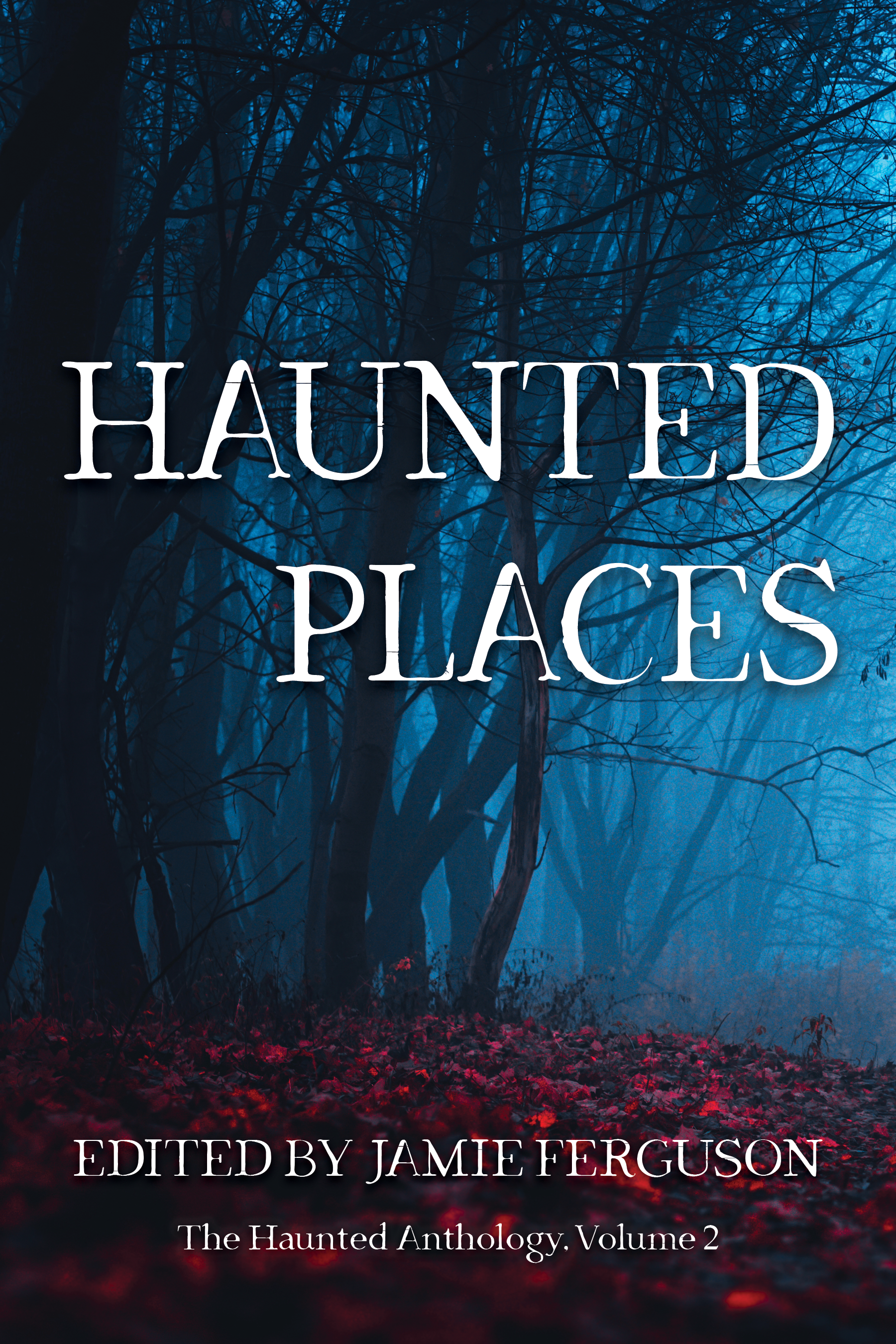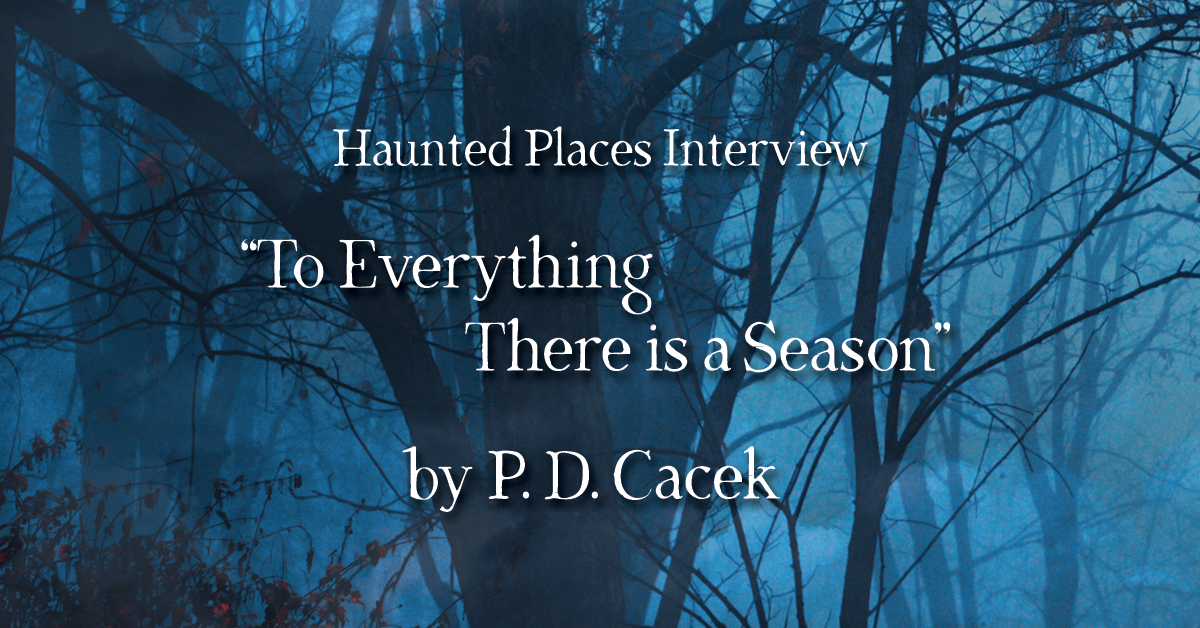Interview: “To Everything There is a Season” by P. D. Cacek
A retired writer slips into her old office—and finds that not all the characters she created are ready to say goodbye.
In “To Everything There is a Season,” P. D. Cacek spins a gentle, wistful ghost story about creation, memory, and the invisible life of fiction. When Rhea Wentworth sneaks back into her former office, now part of a museum, she discovers that the worlds she built—and the characters she loved—have not forgotten her. Tender, literary, and full of quiet wonder, this story invites readers to imagine what lingers when the act of storytelling itself becomes a kind of haunting.
Interview Questions
What does “haunted” mean to you—and how does that idea show up in your story?
For me, besides the standard “haunted means something/someplace inhabited by ghosts,” I’ve come to feel that haunted is just another word for “memories.” What is a ghost if not a memory of a person? What is a haunted house if not a collection of memories? What is a book or a story if not a memory created by an author? It’s not real, it’s not solid, it only exists in the author’s mind…a ghost, if you will. And sometimes, as in my story, ghosts continue to haunt long after they’re laid to rest.
Did this story start with a particular place, moment, or image that stuck with you?
It didn’t start in any one place…but in a number of places. I was thinking of a location I’d visited. I could picture the area, the sounds, what the buildings looked like, where a certain trail lead, the person I had been with on the trip, and then realized I had never actually been there. It was the setting of one of my novels and the person I could see in my mind was, in fact, only a character I had created for that novel. Now, I do a massive amount of research before I write anything to make sure I get as many details right, but this was the first time reality and fantasy got confused. [Cue The Twilight Zone theme.] This started me wondering if this has ever happened to other authors…and the story was born.
Is the haunting in your story something to fear, understand, embrace—or maybe all of those?
I would have to say it’s decidedly “human”—with all the above. There is fear of the unknown, particularly among the “ghosts” who don’t know what will happen (a very human trait), understanding of why she’s there, and, finally acceptance…if not all of them are in full agreement. They really have no more choice than Rhea has, but they trust her.
What, to you, makes a place feel truly haunted—not just eerie or unsettling?
Once again: memories…but in the truly haunted places there are memories/ghosts that are so strong that they can leak into the real world. I have investigated places where I’ve felt uneasy. And there are some places, like Eastern State Penitentiary in Philadelphia, I won’t walk into. The feeling, the memories are just too strong.
Have you ever imagined your own characters haunting you?
Well…. In my novel, Sebastian, one of my characters becomes obsessed with a small, faceless manikin she names Sebastian and who becomes very real to her. The small, faceless manikin named Sebastian stands by the desk in my office and is currently looking at me. Does he haunt me? Very much…no imagination needed. See the answer to #2. But I’m not sure if they’re haunting me…or I’m haunting them.
What was it like writing a character who feels so closely tied to your own
experiences as a writer?
It’s like painting a self-portrait…and being nearsighted enough not to see all the finer details. To be honest, it was fun. I was able to step into a very familiar world and, to use a familiar term, be just another ghost in the story.
There’s something incredibly moving about the moment Rhea sees all her
characters again. Did any of them surprise you when they showed up?
I wish I could say that happened, but I never start a story/novel until I have written the ending (first) and have the full plot figured out in my head. The one item that did come as a surprise was that I’d forgotten, until I had a character recite it, how much I love Dylan Thomas’ poem.
Have you ever written yourself into a story, like Rhea wrote Ree?
I try not to, although a number of my traits do sneak in from time to time. I generally build a character based on other people to keep myself at a distance, but, that being said, I am currently working on a novel that has a lot of “me” in it…more or less.
What’s your favorite part of this story?
The ending, of course. That to me, if we are given a final choice, would be the perfect way to spend eternity.
What are you working on now—and what’s fun or exciting about it?
I’m going back to my horror roots with my next novel. Entitled Killing Frost it deals with weather phenomenon called the “pogonip,” which comes from the Shoshone word payinappih meaning cloud, and is a dense winter fog containing ice particles that form in the deep valleys of the Western U.S. I’ve set the story in two imaginary mountain towns in Colorado based (loosely, especially in terms of their actual geographical locations) on Nederland and Ward.
That’s the fun part.
This is the exciting and “interesting” part:
I am very familiar with Nederland and love visiting it, so when my son moved there with his then girlfriend (now my daughter-in-law) I was thrilled. Occasionally they’d go on vacation and I’d bunny-sit their two Lionhead Rabbits and it was during one of this bunny-sitting visits, that I began to plot out Killing Frost. I knew I wanted Nederland to be the inspiration for one of the novel’s towns, but also decided to create a purely fictional “old mining camp turned into small mountain town” which would suffer the brunt of the horror I planned to visit upon it. So, I began making notes on what this town would look like, who would live there, and flesh out the character I had decided would
become my literary doubleganger. When that was done, I sat down and (after writing the ending, which is how I begin every novel and story), wrote the first scene describing the “me” character’s house and the view from the front deck/windows that overlooked the small town to the mountains and canyons beyond. It was a great view and would, in a later scene, show a dense wave of fog filling up one of those canyons.
Cool scene, huh?
Then, a few years later, my son and daughter-in-law (still a year out) bought a house up in a small mountain town above Nederland called Ward and asked me to bunny-sit while they went on vacation. I was thrilled and, since I was in PA at the time, never saw their new place.
So, you can imagine my surprise when I arrived and saw that their new house, that I had never seen, was identical to the one I’d described in my new novel…right down to the view from the front deck and windows. I was literally standing in the house I had imagined. It was an odd sensation.
A few days later I stood on the deck and watched a cloud of fog drift down the side of mountain to the canyon below. I took a picture and have it on my desk for inspiration.
Interesting, no?
Sometimes, it seems, hauntings are more than just ghosts.
About the Author
P. D. is the author of over 200 short stories, and has won both a World Fantasy Award and a Bram Stoker Award for her short fiction. She’s written seven novels: Night Prayers, Canyons, Night Players, The Wind Caller, The Selkie, Second Lives, the follow-up novel, Second Chances, and Sebastian.
“Horror is an emotion, something that reaches past all the barriers and finds the one dark corner of our self-image that has not grown up. Horror doesn’t have to include dismemberments or gushing wounds or ancient demons dredged up by a new housing development. Anything, even a simple evening’s walk, can be horrific if you look at it the right way…and I do.”
Find Trish at: P. D. Cacek
Read the Story
“To Everything There is a Season” appears in Haunted Places, available now from Blackbird Publishing.
📚 Buy the book from your favorite store


